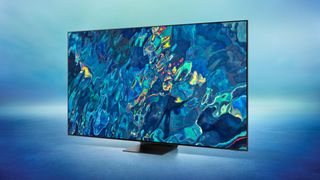Next-gen mini-LED 4K TVs are set for very welcome price drops
But there are two types of mini-LED, and one is cheaper than the other…

One of the biggest TV stories since 2021 has been the arrival of mini-LED tech in TVs. This is a type of backlight for LCD that uses – you guessed it – smaller LEDs so that more lights can be packed into less space, making for ultra-thin TVs with dazzling HDR. Though TCL had introduced the tech before 2021, it really took off with Samsung offering the technology worldwide in some of the best TVs of the year, and at this point you can find also find it in TVs from Sony, LG, Philips and Hisense.
The one problem? It's not cheap. It requires more advanced manufacturing than regular LED TVs, which means premium prices. There has been great progress just in the last year, with the price of Samsung's 2021 models (such as the Samsung QN90A) dropping massively since their launch, and it was good to see that Samsung's 2022 TV range launched at slightly lower prices than its 2021 equivalents in many cases. That was in stark contrast to the price of 2022 LG OLED TVs, including the LG C2, going up compared to last year's models.
But what we're really hoping for is mini-LED to become more common in mid-range TVs – and while that won't happen overnight, there are good signs for further price drops coming from the manufacturers.
On top of the general on-going price reductions on making LCD screens, a report in Digitimes says that there's some tough competition brewing between different screen makers – and tough competition usually means a drop in prices as different makers try to undercut each other.
There are two factors in particular that Digitimes notes are driving big price drops in the Chinese market in particular, but both apply globally: fewer people buying TVs, meaning that companies are dropping prices to try to get people to buy; and the lower TV sales mean that more panels are being made than are actually in demand, so the asking price per panel falls.

Analysis: expect cheaper mini-LED TVs, but know that there are two types of mini-LED
One thing that's important to note is that there are two types of mini-LED, one of which tends to offer superior image quality to the other, and is also (predictably) more expensive. We're going to see a lot of cheaper mini-LED sets coming our way this year, and we expect to find that mini-LED models from the likes of TCL massively undercut the prices from the likes of Samsung despite both coming down a bit in price.
As noted by Digitimes, the cheaper TVs will generally use Package-on-Board (PoB) mini-LED tech, while the more expensive models will use Chip-on-Board (CoB) mini-LED. The technical difference is not that essential to know (CoB features multiple LED units attached directly to a circuit board per lighting unit; PoB features single LED units each in their own little device package, which are then attached to the circuit board) – but the end result is fairly different.
Get daily insight, inspiration and deals in your inbox
Get the hottest deals available in your inbox plus news, reviews, opinion, analysis and more from the TechRadar team.
CoB mini-LED screens can have the angle of their light shaped more effectively than PoB screens, which means you'll get less light leaking from bright areas (where you want it) to dark areas (where you don't). That's why the likes of the Samsung QN900B genuinely take on OLED for impressive contrast and black levels. You're more likely to see 'blooming' when dark areas are next to light areas in the less expensive models.
Ultimately, people will buy the TV they can afford – and though the CoB tech being used by Samsung and Sony will almost certainly produce superior results, PoB tech should still give us better picture quality than we've had from LED TVs in the past at mid-range prices, so we're excited to see whether mini-LED sets can take control of our list of the best TVs under $1000 and best TVs under £1000 in 2022.

Matt is TechRadar's Managing Editor for Entertainment, meaning he's in charge of persuading our team of writers and reviewers to watch the latest TV shows and movies on gorgeous TVs and listen to fantastic speakers and headphones. It's a tough task, as you can imagine. Matt has over a decade of experience in tech publishing, and previously ran the TV & audio coverage for our colleagues at T3.com, and before that he edited T3 magazine. During his career, he's also contributed to places as varied as Creative Bloq, PC Gamer, PetsRadar, MacLife, and Edge. TV and movie nerdism is his speciality, and he goes to the cinema three times a week. He's always happy to explain the virtues of Dolby Vision over a drink, but he might need to use props, like he's explaining the offside rule.
Most Popular

